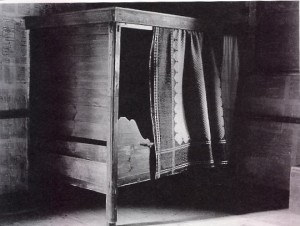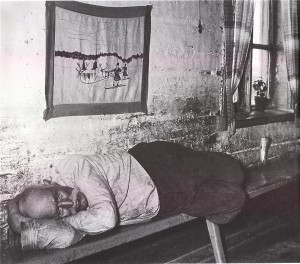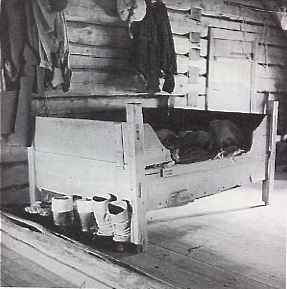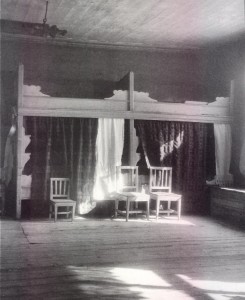
Traditional Enclosed Bed
Suomalainen sänky (The Finnish Bed), by ethnologist Leena Sammallahti and researcher Marja-Liisa Lehto (SKS 2006), is an illustrated history of Finnish sleeping arrangements, from simple benches along the wall, once common in many farmhouses, to elaborately carved and cushioned laps of luxury from upper-class homes. Sammallahti wanted to place the Finnish bed into the spotlight that it deserves and as a result we now have an illustrated history of the Finnish bed. “Ever since I was a child I have not slept very well, so the bed occupies my mind in this respect”, Sammallahti says.
Her recently-published book, Suomalainen sänky (“The Finnish Bed”) presents the evolution of Finnish beds from solid sleeping platforms to ornate canopy beds, and to models that can also serve as sofas as well as of bunk beds. The beds of the Tornio River Valley stand out in their magnificence says Sammallahti. “They have elegance and richness, which I have always loved”.

Sleeping Bench
The seeds of the book were sown in the late 1960s when Professor Niilo Valonen, a legend in Finnish ethnology, used students to photograph the interiors of farm homes, creating an illustrated record. Sammallahti was one of those young student assistants at the time. “Once when I took pictures of furniture, a salesman selling new furniture appeared. He thought that I was a competitor. He could hardly believe that anyone would be interested in old furniture. At that time it was used as firewood,” Sammallahti recalled. With her book on Finnish beds, Sammallahti feels that she has completed one aspect of a major project that her mentor was not able to finishin hbislifetime. Valonen’s intention had been to study the villages, yards, buildings, and interiors of farm living in Finland.
Sammallahti lives in Pori in an old row house originally built for factory workers. In Helsinki she has her “travel suite”, created from the old sauna building at the back of a traditional 1950’s house in Herttoniemi. The furnishings of both homes give an indication of the profession of the person who lives there. “Actually, only the computer is new”, she laughs. “Already as a schoolgirl, I went to auctions, looking for old objects.” The author’s favourite bed was inherited from her grandmother. It is a model that opens from the side. The wood is carved, showing pictures of doughnuts and biscuits. However, usually she sleeps in a pine bed from the 1920’s, as it is pleasantly wide.

Freestanding Bed
A bed is where people are born, die, and make love. In medieval times, taking a bride to bed was actually written into the legislation: a marriage was considered valid only after it could be proved that a couple had spent a night under the same sheets.
Sammallahti’s memories of bed also surge with intimacy. “I remember how my grandmother’s sister, a midwife, took me, a child crying for lack of sleep, next to her under sheepskin blankets. And how my fiancé and I shared a Heteka metal frame bed in the hot attic of a summer cottage.”
Sammallahti has been retired now for a few years but continues to do research. “After being relieved of the obligations of my job, I have dived into the sublime deep waters of a researcher.” The aquatic metaphor is no coincidence. The author is the descendant of a maritime family with origins in the outer islands in the Gulf of Finland, which Finland lost in the war to the Soviet Union. “As a child I was allowed to sail in a boat incredibly freely. During the holidays, I was allowed to go with my father in a steamship to the harbours of Europe.”

Double Loft Bunk Beds
Sammallahti received her doctorate from the University of Helsinki in the early 1980’s. After that, she worked at a number of jobs, including that as the head of the Finnish Maritime Museum, and the museum of the Satakunta region. “I have seen how the museum sector grew along with Finnish prosperity. Now it is sad that it is necessary to reduce funding”, she notes. “Museums are the only organisations that store old objects. And with them, we tell about values and meanings – spiritual matters.”
One of the Finnish museums in which you can see these self-same beds for yourself is the Lyytikkälä Museum Farm in South Karelia. The Lyytikkälä Farm’s history began in 1722 and it was opened as a museum in 1989. The old farmhouse has fixed benches built along the walls of the main room (the tupa) while along the back wall there are beds similar to some of those shown above. In years past, the sons of the owner, the farm-workers and visiting guests slept here at night (in summer, they slept in the farm sheds).
And of course, there’s the obligatory folk song about beds… Istuinpa sankys laidalla (I Sat on Thy Bed)


